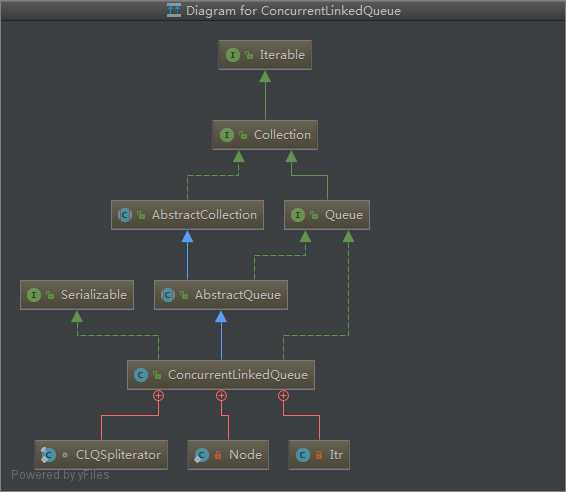Java 并发编程 --- ConcurrentLinkedQueue
Posted kaneziki
tags:
篇首语:本文由小常识网(cha138.com)小编为大家整理,主要介绍了Java 并发编程 --- ConcurrentLinkedQueue 相关的知识,希望对你有一定的参考价值。
ConcurrentLinkedQueue是非阻塞无界的,基于FIFO原则,线程安全的队列,新节点的插入都是在队列的尾部插入的(tail节点),该队列适合于多个线程共享同一个集合时使用。
结构:

构造函数
/**无参数构造函数,默认创建一个节点为nul的队列,head、tail节点同时指向null节点**/ public ConcurrentLinkedQueue() { head = tail = new Node<E>(null); } /**有参数构造函数,传递一个集合,通过遍历集合将集合中的数据保存在队列中(从尾节点插入)**/ public ConcurrentLinkedQueue(Collection<? extends E> c) { Node<E> h = null, t = null; for (E e : c) { /**检查是否为空**/ checkNotNull(e); Node<E> newNode = new Node<E>(e); /**初始队列为空,直接将head、tail同时指向该节点**/ if (h == null) h = t = newNode; else { /**添加到尾节点**/ t.lazySetNext(newNode); t = newNode; } } /**在参数为null或者size为0执行**/ if (h == null) h = t = new Node<E>(null); head = h; tail = t; }
offer插入
/**插入操作执行在tail节点,队列是无界的,不会返回false值**/ public boolean offer(E e) { /**检查是否为空**/ checkNotNull(e); final Node<E> newNode = new Node<E>(e); for (Node<E> t = tail, p = t;;) { Node<E> q = p.next; if (q == null) { // q为空表明,tail的next节点为null(即tail节点就是尾节点) if (p.casNext(null, newNode)) { /**执行cas的交换操作,将p(tail)节点的next节点设置成newNode节点,此处是CAS操作, *即使存在多线程操作一次只会有一个几点插入到队列尾部 **/ if (p != t) // 一次跳跃两个节点设置tail节点 casTail(t, newNode); // Failure is OK. return true; } // Lost CAS race to another thread; re-read next } else if (p == q) // We have fallen off list. If tail is unchanged, it // will also be off-list, in which case we need to // jump to head, from which all live nodes are always // reachable. Else the new tail is a better bet. p = (t != (t = tail)) ? t : head; else /**当多个线程同时执行offer操作时,cas失败的线程会执行该操作,设置q节点为tail节点,执行下一次循环**/ p = (p != t && t != (t = tail)) ? t : q; } }
add插入
add插入操作实际上调用的就是offer操作 public boolean add(E e) { return offer(e); }
poll出队列
poll出队列: public E poll() { restartFromHead: for (;;) { //从head节点开始遍历 for (Node<E> h = head, p = h, q;;) { E item = p.item; //head节点不为null并且cas操作将head节点设置为null成功 if (item != null && p.casItem(item, null)) { // Successful CAS is the linearization point // for item to be removed from this queue. if (p != h) // hop two nodes at a time //更新head节点 updateHead(h, ((q = p.next) != null) ? q : p); return item; } else if ((q = p.next) == null) { //多线程获取节点失败,同时队列中只有一个节点(或者本身队列为空) updateHead(h, p); return null; } else if (p == q) continue restartFromHead; else //获取next节点 p = q; } } }
peek出队列
/**peek操作是获取队列的head节点,只获取不移除**/ public E peek() { restartFromHead: for (;;) { for (Node<E> h = head, p = h, q;;) { E item = p.item; if (item != null || (q = p.next) == null) { updateHead(h, p); return item; } else if (p == q) continue restartFromHead; else p = q; } } }
size操作
/**size操作返回队列中节点的数量(数量大于Integer.MAX_VALUE时,返回Integer.MAX_VALUE,但是数据不准确, *该队列是线程安全的队列,在获取size操作时可能存在其他的add/remove操作在进行 **/ public int size() { int count = 0; for (Node<E> p = first(); p != null; p = succ(p)) if (p.item != null) // Collection.size() spec says to max out if (++count == Integer.MAX_VALUE) break; return count; } /**获取第一个没有被删除,可用的节点(可以看做是poll/peek操作的变体)**/ Node<E> first() { restartFromHead: for (;;) { for (Node<E> h = head, p = h, q;;) { boolean hasItem = (p.item != null); if (hasItem || (q = p.next) == null) { updateHead(h, p); return hasItem ? p : null; } else if (p == q) continue restartFromHead; else p = q; } } }
remove操作
remove操作: /**如果队列中存在多个相同的值,每次只会删除第一个**/ public boolean remove(Object o) { if (o != null) { Node<E> next, pred = null; //从队列中第一个可用节点(有效节点)开始遍历 for (Node<E> p = first(); p != null; pred = p, p = next) { boolean removed = false; E item = p.item; if (item != null) { if (!o.equals(item)) { next = succ(p); continue; } //将remove的节点值置为null removed = p.casItem(item, null); } next = succ(p); //如果remove节点有前驱节点,将前驱节点的next指向remove节点的后继节点 if (pred != null && next != null) // unlink pred.casNext(p, next); if (removed) return true; } } return false; }
containts操作
containts操作: /**contains操作与remove操作极其相似,只是不会进行remove,该方法判断结果并不准确,可能存在删除操作**/ public boolean contains(Object o) { if (o == null) return false; for (Node<E> p = first(); p != null; p = succ(p)) { E item = p.item; if (item != null && o.equals(item)) return true; } return false; }
以上是关于Java 并发编程 --- ConcurrentLinkedQueue 的主要内容,如果未能解决你的问题,请参考以下文章